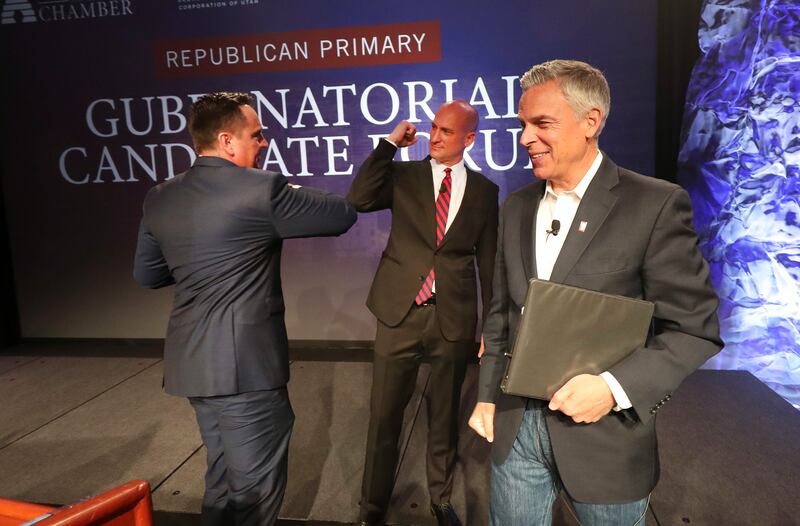SALT LAKE CITY — With temperatures soaring, it may be time to sit back in the grass and contemplate the world. Here’s a bit of cloud gazing:
Party loyalty
So, former Gov. Jon M. Huntsman Jr. is trying to get people to register as Republicans in order to vote for him in the party’s closed gubernatorial primary next month; and now former state Democratic Party Chairman Jim Dabakis says he’s crossing over so he can vote (for some unnamed candidate), too. He told the Deseret News he’s urging everyone to “get into this fixed, rigged election.”
This has put some Republicans in a tizzy. Former House Speaker Greg Hughes told the Deseret News that people who register with the party for the primary without really believing in its principles are doing something “akin to voter fraud.”
Normally, I would say this is a lot of hullabaloo over nothing. Studies have shown that crossover efforts generally don’t amount to much. As one study several years ago by a University of Central Arkansas professor concluded, crossing over goes against the logic most voters use to make decisions, and most of them aren’t clued into politics enough to get in on the plan.
Add today’s hyperpartisan atmosphere, and it’s hard to imagine people switching parties and still keeping food down.
Another study years ago looked at exit polls from closed primaries (where you have to be a registered party member to vote) and found that crossover voters made up a small group, maybe between 1.9% and, in the most extreme case, 7% of votes cast.
But don’t be so fast to dismiss the tactic this year. Utah’s Republican gubernatorial primary will be a contest among four candidates. Four years ago, about 230,000 people voted in the Republican gubernatorial primary. Based on that, even a small 2% crossover would equal about 4,600 votes, which might be valuable in a close four-person race.
Of course, that assumes all the crossovers vote for the same candidate. This could be an interesting tactic to watch.
Hong Kong flu?
Some pundits say we’re making the wrong comparisons by looking back at the 1918 flu pandemic in light of today’s COVID-19. They point to the generally forgotten 1968 Hong Kong flu, which killed an estimated 100,000 Americans, mostly over 65, and did absolutely nothing to the economy.
It struck in the fall but didn’t stop the NFL, NBA, NHL or college football. Schools continued on fairly normal schedules, with some exceptions. People carried on as normal, except that they might have washed their hands more and used rubbing alcohol to wipe down surfaces.
A look at newspapers back then shows people were even making fun of the illness. Art Buchwald did a column about using the flu as an excuse to get out of things.
The conservative National Review said people back then were “more resilient, less vulnerable to groupthink. …” The Wall Street Journal quoted Malte Thiessen, a German historian specializing in pandemics, as saying better medicine and longer life expectancy today has reduced our tolerance for disease and death.
Maybe. But before we go too far down this road, consider that the nation this week is passing the 100,000 death mark, and the virus is still not under control despite closing the economy. The Journal also quoted a professor from the Institute for Global Studies at the University of Minnesota, who noted that mortality rates were significantly lower in 1968 than with the coronavirus today.
Local control?
If the best government is the one closest to the people, why won’t health officials and the governor’s office let the town of Bluff remain at a higher risk level for COVID-19?
Bluff is a town with a lot of senior citizens, bordering on the hard-hit Navajo Nation. The mayor says people are still being flown out for hospital care.
Seems like the folks there ought to decide for themselves, which, of course, is what will happen regardless of what the state says. A lot of businesses will keep higher-level restrictions in place.
A green port?
The Utah Inland Port Authority may have been planning on electric trucks, environmentally friendly buildings, air quality monitoring and environmental buffer zones all along, but the inclusion of those things in the five-year plan unveiled recently takes the air out of any future protests, if the questionable tactics of those protesters left any air to begin with.


